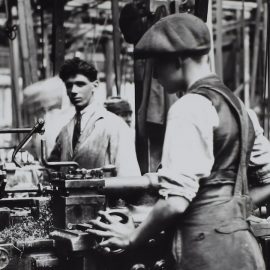

This article is an excerpt from the Shortform book guide to "Turn the Ship Around" by L. David Marquet. Shortform has the world's best summaries and analyses of books you should be reading.
Like this article? Sign up for a free trial here .
What difference did Captain David Marquet make during his time with the USS Santa Fe? What can we learn from his leadership legacy?
David Marquet revolutionized naval leadership when he commanded Santa Fe. He departed from the traditional model in several ways, most notably by assuming that everyone can be a leader. He built a powerful leadership legacy that can instruct and inspire all of us.
Read more to learn about the leadership legacy of Captain Marquet.
Reflecting on Leadership
Marquet and his officers had read and discussed Stephen Covey’s book, The 7 Habits of Highly Effective People, so he was pleased when Covey, who had sought Navy permission to ride a submarine, was assigned to Santa Fe.
Covey’s visit, during a short proficiency training run in the Hawaiian Islands, offered Marquet an opportunity to reflect on what his team had accomplished under the leader-leader empowerment model.
This list included:
- Traveling 40,000 miles safely
- Making port calls in six countries without any behavior problems
- Maintaining the sub at total operational readiness, unhindered by any repair, maintenance, or personnel issue
- Reenlisting 19 crew members while on deployment, setting the bonus award record
- Awarding 22 submarine qualifications and qualifying 290 individual watch stations
- Demonstrating key capabilities in the torpedo exercise, transiting straits safely multiple times, and picking up the SEALS.
- Most importantly, increasing retention from three reenlistments in 1998 to 36 in 1999; officer retention went from 0 to 100%
Santa Fe’s retention numbers increased primarily because of the “Chiefs in Charge” program—junior enlisted men aspired to become chiefs, because those jobs were now central to the submarine’s operation. Prior to leader-leader, the chiefs enjoyed certain privileges but weren’t seen as particularly relevant.
In addition:
- Santa Fe was awarded the Arleigh Burke Fleet Trophy for the submarine, ship or aircraft squadron that improved in battle efficiency the most in a year.
- In 2001, Santa Fe received a record-high grade on its reactor operations exam.
The results provided powerful evidence of Marquet’s leadership legacy. The accomplishments were undeniable.
A Different Kind of Leadership
Marquet’s leadership legacy is due to the ways he deviated from the traditional leadership model:
- Reviewing people rather than reviewing the work.
- Requiring fewer reports and checkpoints.
- Giving fewer orders and making fewer decisions than a traditional leader would, thus developing leadership at all levels.
Nurture Innovation
Eighteen months after Covey’s visit, Santa Fe was on deployment again, operating in the Strait of Hormuz at periscope depth, when the submarine developed a problem. There was an oil leak the crew couldn’t fix at sea and the submarine was running out of oil. However, Santa Fe’s empowerment culture saved the day.
They spotted a navy resupply (combat support) ship, USS Rainier, several miles away and decided to ask for oil. Protocol required making a supply request 36 hours in advance. However, the crew ignored the bureaucratic process, which was unheard of, and simply contacted the ship and asked for oil.
Rainier’s captain agreed to provide oil and also to assist in several other ways as well. He invited Santa Fe to send over its outgoing mail plus any crew members needing dental checkups. When the crew members returned from their checkups, they brought fresh fruits and vegetables and newspapers. Because the crew came up with an innovative resupply solution and capably pulled it off, Santa Fe was able to continue its defense mission rather than diverting to port for an oil fill-up.
The crew was not only empowered to make decisions, but it was also emancipated to make unconventional ones. This is a significant aspect of Marquet’s leadership legacy.
Don’t Just Empower, Emancipate
It’s necessary to empower people under the leader-leader model because people have been disempowered in the past. But empowerment alone isn’t enough to change the way things work because it’s a variant of the top-down approach (someone does the empowering).
Along with empowering employees, leaders need to release or free them to apply their talents, energy, and creativity, by getting out of the way. Teams are emancipated when they have decision-making authority supported by competence and clarity. You no longer need to empower them, nor can you, because their sense of power comes from within.
An Impressive Leadership Legacy
Santa Fe’s achievements and innovations under Marquet’s leadership lasted long after his departure and spread throughout the submarine force.
Twelve years after Marquet took command of Santa Fe, Commander Dave Adams, former weapons officers under Marquet, took charge. Also, three officers from Santa Fe were chosen from hundreds of candidates by the chief of naval operations for special assignments in Afghanistan.
Santa Fe produced additional leaders in disproportionate numbers compared to other submarines. Both of its executive officers were selected to command submarines, and they were later selected for major command positions. Three department heads were promoted to executive officer and then to commanders of their own submarines. Many enlisted men were promoted as well.
In terms of operational performance, Santa Fe won the award for best chiefs’ quarters for seven years in a row and the Battle “E” award for most combat-effective submarine three times in 10 years. Deliberate action was adopted across the submarine force. Two other Santa Fe mechanisms—the “I intend to ..” procedure and certification—were picked up by others.
The leader-leader model is the only one that can produce top performance and long-term excellence. If the model can turn the Navy’s worst-performing submarine into its best, it can work in any organization.
The leadership legacy of Captain Marquet extends well beyond the Navy and inspires leaders everywhere.

———End of Preview———
Like what you just read? Read the rest of the world's best book summary and analysis of L. David Marquet's "Turn the Ship Around" at Shortform .
Here's what you'll find in our full Turn the Ship Around summary :
- How a captain turned the U.S. Navy’s worst-performing nuclear submarine crew into one of the best
- The principles for developing leaders at all levels to create a passionate, high-performing workforce
- Why the "leader-leader" model works better than the "leader-follower" model






